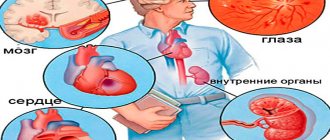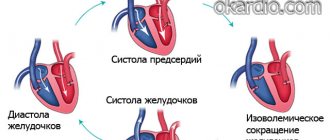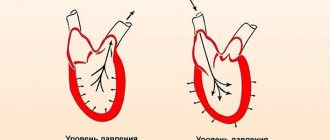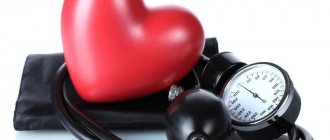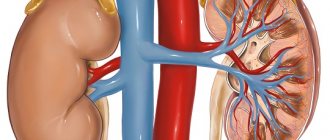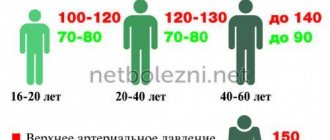Blood pressure indicators are becoming an important marker in determining a person’s well-being. Moreover, doctors equally monitor both the increase and decrease in readings on the tonometer. At the same time, people often have questions. For example, since there are two indicators - upper and lower pressure - which one is more important?
Associate Professor of the Department of Hospital Therapy named after A.N. Academician P. E. Lukomsky Faculty of Medicine, Russian National Research Medical University named after. N. I. Pirogova, Ph.D., cardiologist, therapist, functional diagnostics doctor Maria Benevskaya .
Set priorities
“The first thing I would like to talk about when answering the question about which indicator is more important is what blood pressure actually is and what the measured parameters indicate. Blood pressure (also called blood pressure) is the pressure that blood exerts on the walls of blood vessels. This parameter is one of the indicators of the vital functions of the body,” notes Maria Benevskaya.
When measuring blood pressure, as the cardiologist says, two types are determined: with each heartbeat, the blood pressure fluctuates between the highest, systolic (from the ancient Greek “compression”), and the lowest, diastolic (from the ancient Greek “rarefaction”) "), which are colloquially called upper and lower. Thus, the magnitude of the force acting on the vessels is determined by two parameters: upper (systolic) and lower (diastolic) pressure. Therefore, we cannot say that any of these parameters is more important. They both have their meaning.
“Everyone knows that the normal blood pressure of a healthy person (systolic/diastolic) is 120 and 80 mmHg. Art., but we must also remember that normal boundaries change depending on age and existing diseases. The difference between systolic blood pressure and diastolic blood pressure is called pulse pressure and is normally 30-50 mmHg. Art.,” the specialist emphasizes.
We fight the pressure. 8 drinks for hypertensive patients Read more
Method of measuring blood pressure
Advertising:
Blood pressure is examined using a specialized blood pressure monitor. It is recommended to adhere to step-by-step methods of carrying out the procedure so as not to obtain overestimated or underestimated results.
- Select a cuff size that fits the shoulder.
- Provide the best conditions. The person should not be under stress or physical activity. The temperature should be room temperature, not cold or excessively warm.
- Taking into account additional factors. It is recommended to measure the indicator 1 hour before active physical activity, eating food and coffee, or smoking.
- Select the optimal table level. It should be of such a height that the cuff on the arm is located in the area of the intercostal line. If it moves by 5 cm or more, the degree of blood pressure will decrease or increase. The error will be 4 mm.
- Location of the pressure gauge scale. It should be at eye level so that the patient does not make mistakes during the procedure.
- Patient location. He should sit straight, leaning on the back of the chair. The body should relax, the legs should be placed straight, and should not be crossed. The hand for measuring pressure is placed on the table and relaxed. Parts of the body should not be tense during the procedure.
- Air pumping. The approximate state of the patient's blood pressure is assessed. During the pumping process, wait until the numbers on the tonometer reach this limit, then pump up another 30 mmHg. If the patient pumps the tonometer above this value, severe pain will begin in the arm.
- Reset. The first sound is formed, which is called the Short tone phase. This is an indicator corresponding to the upper value of blood pressure. When these tons completely disappear, phase 5 will form. This indicator will correspond to the lower pressure criterion.
- Repeated study. It can be carried out only 5-7 minutes after the initial use of the tonometer. During the analysis, the average indicator is calculated, which will be the most accurate and optimal for the patient. A one-time procedure may show an error.
- The first analysis is performed on both hands at once. A secondary study is carried out on only one upper limb.
If the heart rhythm is disturbed, measuring blood pressure becomes difficult. Therefore, it is recommended to evaluate the indicator only with the help of medical personnel.
Renal or cardiac?
There is an opinion that the upper pressure indicator is cardiac, and the lower one is renal. “The top number is systolic blood pressure, it shows the pressure in the arteries at the moment when the heart contracts and pushes blood into the arteries, it depends on the force of the heart contraction, the resistance that the walls of the blood vessels exert, and the number of heartbeats per unit time. Therefore, in general, we can say that this indicator reflects the work of the heart, although, of course, other factors also take part in this process,” says Maria Benevskaya.
It is also not worth ruling out that the lower indicator reflects kidney function. “The bottom number is diastolic blood pressure, which shows the pressure in the arteries when the heart muscle relaxes. This is the minimum pressure in the arteries and reflects the resistance of peripheral vessels. Since vascular tone is regulated by chemicals and the autonomic nervous system, lower blood pressure indicates the extent to which neurohumoral regulation is carried out correctly. In turn, neurohumoral reactions occur mainly in the kidneys, which is why there is an opinion that the “lower” pressure is renal. But it would be more correct to note that lower pressure reflects the work of blood vessels and kidneys,” says the cardiologist.
Lack of oxygen, loss of strength. How pressure surges affect the brain Read more
Causes
It cannot be stated that the factors that cause upper blood pressure to reach critical levels have been thoroughly studied. There are different forms of the disease that directly affect the increase in blood pressure, as well as inadequate conditions of the nervous and metabolic systems, including ion tissue metabolism.
The upper pressure exceeds the norm due to the following factors:
1. Mental overstrain in 10-15%, stress, since adrenaline (stress hormone) has a strong effect on the heart. It begins to contract more often and emit more blood.
2. An increase in the ejection of blood by the heart per contraction at a high sodium concentration.
3. Spasms of smooth muscles that support the vascular walls and impaired regulation of blood pressure due to increased calcium levels.
4. Accumulation of atherosclerotic plaques on the vascular walls (20-25%), development of sclerosis. When the lumen of the arteries narrows, the heart increases its impulses to move blood, which increases blood pressure.
5. Active substances that are released by the kidneys when blood supply deteriorates. The substances contribute to a steady increase in pressure, including upper pressure.
6. Constant use of medications:
- oral contraceptives with large doses of hormones;
- medications that reduce appetite;
- glucocorticoids: Prednisolone, Dexamethasone;
- anti-inflammatory drugs: Indomethacin, etc.
7. Symptomatic hypertension, diabetes mellitus, dehydration.
8. Sedentary lifestyle and excess weight.
9. Hereditary factors.
10. Drinking alcohol and salty foods, smoking.
Importance of indicators
So is it possible to conclude which of these indicators is more important? “As we have already figured out, each of these parameters has its own meaning, so they are both important. Currently, it is also customary to distinguish between isolated systolic hypertension, when only the upper pressure is increased, and isolated diastolic hypertension when only the lower pressure is increased. Each of these forms has its own prognostic significance and some features in treatment, so it is necessary to approach the identification and correction of these types of hypertension with equal attention,” notes Maria Benevskaya.
Safe reduction of upper pressure
What to do if the myocardium gets used to pressure surges due to atherosclerosis of blood vessels, but the person does not feel them? You can lower blood pressure with Papazol if it was prescribed by a doctor after examining tests, ultrasound of the heart muscle and ECG. More often, universal drugs are selected individually: they can reduce blood pressure and have an antispasmodic effect - relax blood vessels and eliminate discomfort in the gastrointestinal tract and urinary tract. A sharp jump in the upper reading can be stopped with one Nifedipine capsule with water and using the following recommendations:
- When the temperature changes, immerse the feet up to 5 times in a basin with hot water (up to 42°C) for 2 minutes, and with cold water for half a minute.
- Apply vinegar lotions to your feet. Moisten the fabric with apple cider vinegar and water (1:1) and stand on it.
- Drink calendula tincture with vodka (1:50) 30 drops with water before each main meal.
- Apply a cold compress to the cervical vertebrae. Leave for 20-30 minutes, then rub your neck with massage oil: 1 tbsp. l. vegetable oil or baby glycerin 3-5 drops of fir, cedar, pine or eucalyptus oil.
- Perform a head and neck massage.
Massage
Regardless of the cause and treatment of high upper pressure, massage is always useful: it improves blood circulation and relieves headaches. It is better to entrust the massage procedure to a specialist.
It is important to know. The skin on the front of the neck on both sides is easily displaced. The skin on the back of the head is thick, so it is difficult to dislodge. The common carotid artery pulsates between the sternocleidomastoid muscle and the trachea, and the subclavian artery pulsates in the fossa under the clavicle.
Movements when massaging the head should be soft, gentle and relaxing, so as not to damage the lymph nodes and vessels located on the neck when moving to the scalp.
The massage is performed with classic movements:
- stroking: planar, grasping, comb-shaped, forceps-shaped and directed from top to bottom;
- rubbing: straight, circular, in the form of strokes and sawing;
- kneading: transverse, longitudinal, pressing, stretching, shearing, forceps;
- vibrating: in the form of puncturing, light tapping, patting and shaking with individual fingers.
Why is massage performed using massage lines? Because they pass along the blood and lymph vessels. From the bridge of the nose they cross the frontal and parietal bones, go along the neck and towards the trapezius muscle. Bypassing the behind-the-ear area, they go to the neck from the temple, from the ears - to the trapezius muscle along the lateral surfaces of the neck, from the bridge of the nose - to the crown of the head, from the brow ridges - to the temples. Using lines and soft classical movements, you can perform self-massage of the head and cervical vertebrae daily for 3-5 minutes.
Pills
You can reduce blood pressure with thiazide diuretics (“Hydrochlorothiazide”, “Hypothiazide”, “Cyclomethiazide”) and sulfonamides (“Indapamide”, “Indal”, “Acripamide”, “Chlorthalidone”), since they can reduce the swelling of the walls of blood vessels and increase their lumen.
To reduce high rates and cardiovascular risk for patients after myocardial infarction, with angina pectoris, heart failure and atrial fibrillation, mono- or combination therapy with beta blockers is used:
- non-selective beta blockers: “Carvedilol”, “Propranol” (“Anaprilin”), “Sotalol”, “Oxprenolol”, “Nadolol”;
- selective beta blockers: Atenolol, Metoprolol, Bisoprolol, Celiprolol, Betaxolol.
During menopause, women are recommended to take Betaxolol or Lokren. What to do if upper blood pressure increases with diabetes? If a patient takes “Glibomet” for diabetes, then an overdose may cause lactic acidosis, in which blood pressure decreases and bradyarrhythmia appears, and consciousness becomes confused. But when taking the drug together with alcohol, including alcohol drops, the upper levels will go off scale, and the symptoms will manifest themselves as headache, vomiting, and palpitations. Therefore, diabetics should take this drug under the supervision of a doctor and stop taking it if there are symptoms of lactic acidosis.
Folk remedies
The bark, flowers and berries of red viburnum are well suited for lowering high blood pressure and as a diuretic:
- A gruel of mashed berries (5-6 tbsp) with honey (200 ml) is infused for 2 hours and consumed before meals, 1 tbsp. l.
- Fresh or frozen berries (100 g) are kept in boiling water (0.5 l) in a bathhouse for up to 20 minutes, after filtering, mixed with honey or sugar and drunk 50-100 ml before each meal and between them.
- Boil 7-10 g of viburnum bark in 250 ml of water for 30 minutes and leave in a thermos for 4-6 hours. After filtering, drink 50 ml three times a day.
Therefore, in order to cope with high levels of upper pressure, it is necessary to strictly follow the doctor’s instructions, use folk remedies and massage, engage in feasible sports and avoid fatty, fried and salty foods.
Attention to the gap
Of course, as experts note, it is also necessary to look at the gap between these parameters. “I repeat that the normal difference between upper and lower pressure is from 30 to 50 mm Hg. Art. All values that do not fit within these limits may indicate the presence of pathology, and this is already a reason to undergo additional examination. Although at the same time this may be due to the individual characteristics of the body and physiological conditions. But in any case, it’s better to see a doctor so as not to miss the disease,” notes Maria Benevskaya.
So, for example, the specialist emphasizes, a small difference may indicate:
- the presence of atherosclerosis of the aorta (deposition of cholesterol in the largest vessel);
- damage to the kidney vessels;
- aortic aneurysm (pathological expansion of a separate section of the aorta with the possibility of rupture or dissection of the walls due to excessive load);
- anemia (decreased hemoglobin levels in the blood) and many other conditions.
“An increase in the difference may be a consequence of osteochondrosis of the cervical spine, aggravated by a malnutrition of the brain (most often vertebrobasilar insufficiency). Diseases of the musculoskeletal system lead to weakening of cerebral blood flow. Hence the problems with upper and lower pressure in general,” notes the cardiologist.
Also, as Maria Benevskaya says, various endocrine diseases can lead to changes in pulse pressure. And this is not the entire range of pathologies that affect this parameter. A change in this indicator can be a “bell” to pay attention to your health.
Hot towel and vinegar. What folk remedies quickly reduce blood pressure? More details
Causes and symptoms of increased heart pressure
All reasons for increased systole are divided into physiological, psychological and pathological. Sometimes an increase in blood pressure is simultaneously provoked by all these factors. A condition in which blood pressure remains above normal for a long period of time is called hypertension.
Physiological reasons for the increase in cardiac blood pressure:
- bad heredity;
- binge eating;
- lack of physical activity;
- abuse of salt in dishes, coffee, strong tea;
- aging of the body;
- excess body weight;
- overwork;
- addiction to tobacco and alcohol;
- taking medications that have a hypertensive effect.
Among women under 50 years of age, there are far fewer hypertensive patients than men of the same age. But the onset of menopause changes the situation: most representatives of the fairer sex have problems with fluctuations in blood pressure.
The psychological reasons for the increase in heart pressure are experiences and stress. Pathological factors of hypertension include:
- atherosclerosis;
- adrenal tumor;
- hyperfunction of the thyroid gland;
- hormonal imbalances;
- diabetes;
- left ventricular hypertrophy;
- vegetative-vascular imbalance of the hypertensive type;
- kidney diseases (organ failure, pyelonephritis);
- malfunction of the aortic valve.
While a person is young, his arteries and heart are in good condition, compensatory mechanisms are immediately activated when blood pressure deviates from the norm. As we age, all organs and systems wear out and begin to function worse. Many elderly people are diagnosed with atherosclerosis and left ventricular hypertrophy. Therefore, as you age, heart pressure standards increase. So, for an elderly person, a systole in the range of 140-155 units will be considered optimal.
Systolic hypertension is manifested by the following symptoms:
- pain in the occipital area and temples;
- dizziness;
- nausea;
- numbness of the limbs;
- fear of death;
- weakness;
- heart rhythm disturbance (tachycardia);
- increased irritability;
- redness of the epidermis;
- deterioration in the quality of vision;
- insomnia;
- tinnitus.
Adjust individually
The question of whether it is possible to adjust indicators separately is also of concern to many. “Basically, all the drugs that we use to correct high blood pressure act on both upper and lower pressure. However, among the classes of antihypertensive drugs, we have the opportunity to select drugs with a predominant effect on systolic or diastolic pressure. Therefore, it is possible to implement a personalized approach to the patient based on his needs,” notes Maria Benevskaya.
For example, she says, medications that have a vasodilating effect will be more likely to cause a decrease in diastolic (lower) blood pressure. And drugs that reduce the force of heart contractions will reduce systolic (upper) blood pressure to a greater extent.
Causes and symptoms of decreased heart pressure
The tonometer numbers decrease for various reasons. People whose heart pressure is below 110 units are called hypotensive. Some people have lower than normal heart pressure from birth, but are completely healthy.
All factors of low systolic blood pressure can be classified into physiological, psychological, and pathological. The first group includes the following negative factors:
- bad heredity;
- strict low-calorie diet, fasting;
- physical fatigue;
- bad habits;
- taking drugs that have a hypotensive effect.
Psychological reasons lie in worries and worries. It happens that the central nervous system cannot cope with stress. Nervous fatigue can lead to a decrease in tonometer numbers.
Pathological factors for a drop in heart pressure are represented by the following conditions:
- hypofunction of the thyroid gland;
- hypoxia;
- diseases of the central nervous system;
- abnormalities in the structure of the myocardium;
- vegetative-vascular imbalance of the hypotonic type;
- bleeding (external or internal);
- hormonal imbalances;
- disruption of the functioning of the endocrine glands;
- dehydration;
- stomach ulcer;
- anemia;
- infectious damage to the body;
- oncopathology.
You can suspect low heart pressure by the appearance of the following unpleasant symptoms:
- weakness;
- drowsiness;
- pallor of the epidermis;
- cold extremities;
- dizziness;
- pain in different parts of the head;
- impaired coordination of movements;
- abnormal heartbeat (bradycardia);
- sweating;
- loss of consciousness;
- deterioration in the quality of vision.
It must be taken into account that there is a concept of working blood pressure. It means those tonometer numbers at which a person has no unpleasant symptoms of hypotension or hypertension, and performance is at a high level.
Characteristic symptoms
ISAH in 50% of cases is asymptomatic until signs of blood flow disturbances in the heart and brain appear. Manifestations are the same for all forms of hypertension:
- headaches of varying localization and intensity;
- discomfort, pain in the projection of the heart;
- nonspecific symptoms of chronic insufficiency of cerebral blood flow: fatigue, mood changes, memory problems, etc.;
- decreased vision, “spots” and darkening in the eyes.
During a crisis at high pressure levels, severe headaches, vision changes, nosebleeds, and dizziness may occur. But more than half of the patients do not have specific clinical manifestations. High blood pressure – an accidental discovery at a doctor’s appointment or at home; Often, general health does not suffer, allowing you to perform normal activities.
Secondary changes in blood flow in the main organs gradually reduce the ability to perform usual activities and lead to disability.
Why you need to contact a specialist
When treating hypertensive syndrome, it is important to understand exactly what factor influenced the poor diastolic pressure readings. For vascular spasm, certain drugs are prescribed, and for insufficient relaxation of the heart, completely different ones are prescribed.
Important:
On his own, the patient cannot understand what exactly the problem is: the blood vessels are strongly compressed or the heart muscle is poorly relaxed. It is important to consult a doctor and find out the causes of the disease.
With low blood pressure, the supply of oxygen to all systems of the body deteriorates, and oxygen starvation, brain and other disorders can develop. High blood pressure threatens stroke, heart attack, blindness, kidney failure and other terrible consequences.
Treatment methods
In cases of secondary ISAH, the disease that causes the high blood pressure is treated.
Therapy of the primary form is carried out with a combination of drugs from several groups:
| Group of drugs | Examples |
| Diuretics | Indapamide Hypothiazide |
| Beta blockers | Atenolol Bisoprolol |
| Calcium antagonists | Amlodipine Verapamil |
| Angiotensin-converting enzyme inhibitors | Enalapril Lisinopril |
| Angiotensin receptor blockers | Losartan Valsartan |
In the case of the primary form, treatment is long-term (sometimes lifelong).
What do the pressure numbers on the tonometer mean?
Almost every family has a tonometer or apparatus for measuring blood pressure. A few decades ago, everyone used mechanical devices. Listening to the pulse required a stethoscope, and deciphering the results required special experience.
The transition to electronic devices has significantly simplified the process of measuring blood pressure. The semi-automatic device, according to the instructions, involves pumping air into the cuff; automatic modifications work without this procedure. The device will display the received data on the LCD screen. Modern models additionally allow you to control your heart rate and other parameters.
Blood pressure is measured in millimeters of mercury. Two indicators are entered into the patient’s card and medical history, separated by a slash: 130/90 mm Hg. Art. The first number is the systolic pressure, the second is the diastolic pressure. The measurement result may be incorrect. Causes:
- the person moved during the manipulation process;
- the hand was tense;
- the blood pressure cuff was below the level of the heart.
The numbers obtained on the right and left hands also differ. For reliability, average indicators are taken as a basis.
Standard blood pressure values
Several centuries of refinement have allowed doctors and researchers to derive average blood pressure (heart) pressure for different groups of people. They are different for men and women. Specific values depend on age and genetic predisposition to certain diseases.
Standard or average values are given in the table below:
| Age | Men | Women | ||
| Upper, mmHg Art. | Lower mmHg Art. | Upper, mmHg Art. | Lower mmHg Art. | |
| 17-20 | 123 | 76 | 116 | 72 |
| 20-30 | 129 | 81 | 127 | 80 |
| 30-40 | 135 | 81 | 135 | 80 |
| 40-50 | 135 | 83 | 135 | 84 |
| 50-60 | 135 | 85 | 135 | 85 |
| 60 + | 135 | 89 | 135 | 89 |
A little analysis shows that with age the difference in values between men and women smooths out. Blood pressure (both lower and upper) gradually increases as you grow older.
Personal blood pressure readings
The standard pressure values given in the table cannot be considered the only correct ones. Performance indicators for a particular person may differ in one direction or another. Only daily monitoring over a long period of time will help determine them. The first measurement is taken in the morning an hour after waking up. The second is evening.
What pressure is considered normal?
Several factors simultaneously influence blood pressure:
- condition of the heart muscle;
- condition of the walls of blood vessels;
- the presence of deposits on the walls of blood vessels;
- person's age;
- human body type;
- a person’s lifestyle and physical activity;
- external factors, for example, region of residence.
If we summarize all these points, we can conclude that the “ideal” blood pressure is determined very individually. Of course, doctors have a standard of 120/80, but this does not mean that absolutely all people will feel good at this pressure. For example, the normal pressure indicator for petite women is 110/70, for athletes who are constantly exposed to physical activity - 130/80. A normal person may have slightly lower or higher blood pressure, and even the slightest changes will be immediately noticeable.
However, there are also extreme limits that doctors consider critical. For example, if the pressure reading is 140/90 and at the same time it tends to increase, then this is a sign of arterial hypertension. In this case, you should definitely consult a doctor, and if your general condition suddenly worsens, call an ambulance.
To bring the blood pressure back to normal, the doctor may prescribe medication. In addition to taking medications, it is necessary to change your lifestyle and eating habits: give up smoking, alcohol, fatty, heavy foods.
Extremely low blood pressure, for example 90/60, indicates that the organs are not receiving enough nutrition: the brain activity of such a person is reduced, and there is a risk of oxygen starvation. Such indicators may indicate concomitant diseases: vegetative-vascular dystonia, anemia, adrenal insufficiency, etc.
